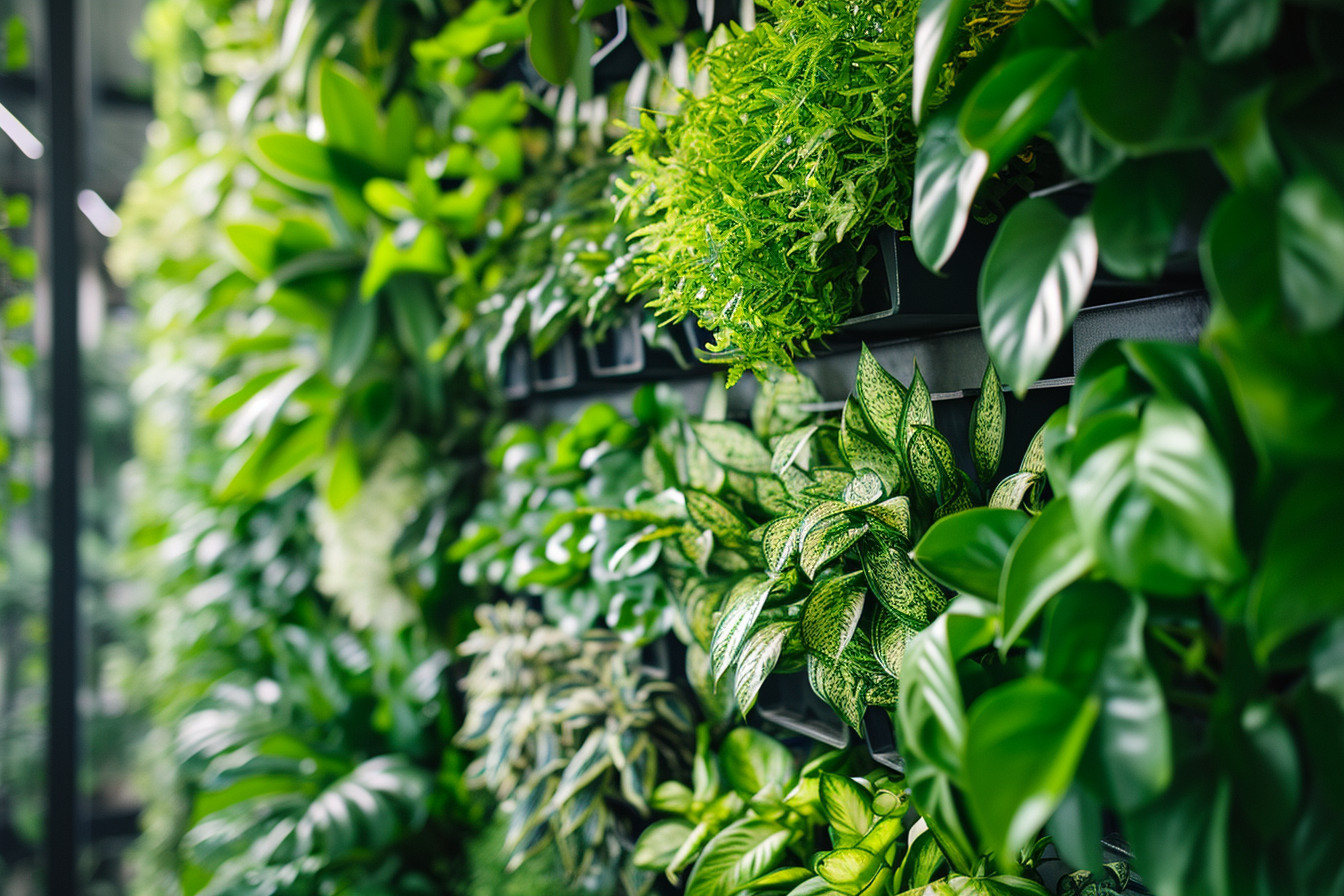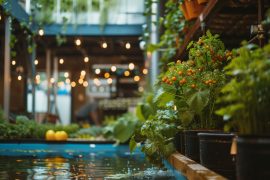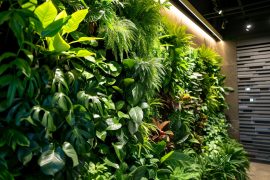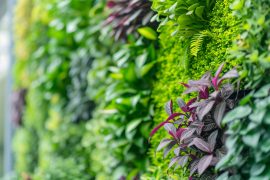Ever find yourself yearning for a slice of the outdoors, but you’re stuck in a concrete jungle? Well, I’ve got the perfect solution for you—setting up your first indoor vertical garden. It’s like hanging a piece of serene nature right on your wall, and trust me, it’s as peaceful as it sounds.
I’m here to walk you through the ins and outs of vertical gardening, making it simple and enjoyable. Forget about those complex gardening terms; I’ll break it all down for you. We’ll explore everything from the tranquility of nurturing your plants to the satisfaction of watching them thrive, all in the comfort of your home.
And don’t worry, I’ve been down this road—a few pots, some soil under my nails, and plenty of green friends to show for it. So, let’s get our hands dirty and embark on this verdant adventure together. It’s storytelling with plants, and the narrative is all yours to create.
Benefits of Indoor Vertical Gardens
While we’re knee-deep in planting and picking the right spot for our indoor vertical garden, let’s take a breath and admire the beauty of what we’re doing. Creating a green oasis in your home isn’t just about aesthetics—it’s about reaping the plethora of benefits this unique setup offers.
Visual Appeal: First off, imagine transforming a bland wall into a lush living piece of art. That’s exactly what an indoor vertical garden does—adds a visual punch that’ll have guests raving and your own eyes wandering for an extra minute every time you pass by.
Air Quality: But it’s not all about looks. My plants are my silent guardians, constantly working to improve the air quality in my home. They take in carbon dioxide and throw out fresh oxygen, creating a cleaner, fresher environment that subtly boosts my mood and health.
Space Efficiency: If you’re worried about space, don’t be. Vertical gardens cultivate upward, not outward, which means even those of us in snug apartments can grow an impressive amount of greenery without forfeiting square footage.
Sound Insulation: Surprisingly, the layers of plants and soil also help in muffling urban clamor. It’s like having an acoustic barrier that dulls down the buzz from outside, offering a more peaceful, serene living space.
| Benefits | Description |
|---|---|
| Visual Appeal | Transforms walls into living art pieces, enhancing the aesthetic of your space. |
| Air Quality Improvement | Acts as a natural air filter, removing toxins and expelling clean oxygen. |
| Space Efficiency | Maximizes vertical space allowing for substantial gardening in small areas. |
| Sound Insulation | Provides a barrier against noise pollution, contributing to a tranquil atmosphere inside the home. |
In terms of health benefits, tending to my indoor vertical garden has become a form of meditation. It’s my little escape from the digital screens and the relentless pace of daily life. Plus, the act of nurturing something living is incredibly rewarding—there’s something special about seeing a plant blossom under your care.
Growing a vertical garden also serves as an educational tool for me and my visitors. It sparks conversations on sustainability, plant species, and the importance of greening our urban environments. It’s a functional display that invites questions and spreads awareness about the simple ways we can contribute to the environment.
Choosing the Right Location
Finding the perfect spot for your indoor vertical garden is like discovering a secret corner of serenity in your home. Just like a quiet nook can become a favorite reading spot, the right location for your garden can transform an ordinary room. It’s all about harnessing the power of nature to foster a peaceful atmosphere.
When I’m picking out a space for a new garden, natural light is the first thing on my mind. Plants are pretty straightforward—they love light. So, a spot near a window with ample sunshine is ideal.
East or West-facing windows are perfect; they provide bright but gentle morning or afternoon light. South-facing windows can work too but watch out for too much direct sunlight which might overwhelm certain plants.
Next, I consider the room’s climate. It’s not just about beauty; your plants need to feel at home. That means avoiding places next to heaters, air conditioners, or drafty windows. These spots can bring sudden temperature changes, which most plants aren’t fans of.
Here’s a little tip: Humidity matters! Bathrooms with natural light can be a surprising choice. They naturally provide higher humidity that many plants, especially tropical varieties, really enjoy. Just be sure there’s enough space so your vertical garden doesn’t turn into an obstacle course every morning.
As for accessibility, it should be a spot where I can easily water and care for my plants without turning into a contortionist. I also consider the weight of the vertical garden—will the wall support it, or will I need to add some reinforcement?
Now let’s talk about air circulation. It’s a biggie because good airflow helps prevent pests and diseases. A little space around your garden where air can move can make all the difference. Don’t shove your garden into a tight corner and expect it to thrive.
Remember, while good airflow is necessary, you don’t want your plants in the path of strong drafts. It can dry them out or cause undue stress.
When selecting the right location, there’s a bit of technical stuff to keep in mind too. For example, the watering system. If you’re opting for a self-watering or hydroponic system, proximity to a water source will save you a lot of hassle. Otherwise, you’ll be lugging water across the house every other day.
Selecting the Perfect Plants
When I began my venture into vertical gardening, I quickly learned that not all plants are created equal when it comes to thriving in this unique environment. My journey to find the right green companions taught me some key considerations that any aspiring vertical gardener should keep in mind.
Light Preferences Matter – This is huge. Bearing in mind the location of my indoor garden, I had to pick plants that suited the natural light available. I realized that ferns and ivies, with their love for shade, did perfectly well in lower light conditions, while herbs like basil and chives needed more sun to flourish.
Root Depth is Crucial – In vertical gardening, there isn’t as much space for roots to spread out. I had to choose plants with shallower root systems. This meant saying yes to succulents and lettuce, and no to deep-rooted plants like carrots and potatoes. Lettuce, for instance, has a short root system making it a stellar choice for my wall-mounted planters.
Weight Considerations – Some plants, especially when they mature, can get heavy. When I was setting up, I had to think about the weight each section of my vertical garden could support. Plants with lightweight soil needs and less bulky growth habits, like spider plants and air plants, became my go-to options.
Humidity and Air Flow – Certain plants thrive in moist environments, but too much humidity can be a recipe for fungal diseases. I found that striking a balance is key. Air plants were a revelation for me—they need good air circulation and can’t stand to be too wet, which makes them perfect for indoor vertical gardens.
Maintenance and Care – Some plants are more high maintenance than others. I wanted a relatively easy experience for my first vertical garden, so I opted for hardy plants known for their resilience. I’ve had great success with pothos and philodendrons; they’re almost indestructible and don’t mind a missed watering.
- Pothos (Epipremnum aureum) – Hardy and versatile, perfect for beginners.
- Spider Plant (Chlorophytum comosum) – Lightweight and easy to care for.
Understanding Lighting Requirements
As I delve into the tranquil world of indoor vertical gardening, I’ve come to appreciate that light plays a pivotal role in helping our green friends thrive. Grasping the type of light a plant requires isn’t just educational—it’s essential. Sometimes, it almost feels like I’m learning a plant’s secret language, and I’m here to translate that for you.
Direct sunlight might be the first thing that pops into your mind when you think about plants, but not every vertical garden dweller yearns for those intense rays. Picture a sunny windowsill that bathes your garden in light for most of the day. That’s a haven for sun-loving plants, but it’s too intense for others.
Shade-tolerant species, on the other hand, are like the introverts of the plant world; they enjoy light, but indirectly, like the dappled sunlight streaming through a sheer curtain. They’re perfect for spaces that don’t get that harsh afternoon sun. Let’s break it down a bit:
- Full Sun: 6+ hours of direct sunlight a day
- Partial Sun: 3-6 hours of direct sunlight a day
- Partial Shade: 3-6 hours of light, without direct sunlight
- Full Shade: Less than 3 hours of direct sunlight, preferably filtered
When I was setting up my first indoor vertical garden, I learned about the importance of plant orientation. Some plants crave the morning sun from an east-facing window, while others might prefer the warmer afternoon light from the west. It’s all about positioning.
Reminder: artificial lighting isn’t just for overcast days and dark corners. It can be a game changer. I’ve seen LED grow lights work wonders, mimicking natural light spectrums to boost growth and keep plants happy even without windows.
Here’s a story that sticks with me: a friend of mine had a gloomy apartment with little natural light. She almost gave up on her dream of an indoor vertical garden until she experimented with grow lights. They transformed her living space into a thriving garden sanctuary. Now, she’s got herbs and ferns flourishing like they’re out in the wild.
Building a Vertical Garden Structure
When it comes to creating your very own Eden indoors, the crux lies in constructing the right kind of vertical garden structure. I remember the initial thrill of selecting materials; it’s like sculpting your piece of the natural world. Let’s start by talking about the skeleton of your green haven: frameworks.
Most indoor vertical gardens rely on stands or panels that consist of shelves, pockets, or even modular panels. No need for a degree in engineering here! Think about what you’re comfortable with assembling and maintaining. Metal frames are sturdy and resistant to moisture, while wooden structures offer a more natural aesthetic but require a bit of extra care to prevent rot.
Where’s the magic in a vertical garden without the right containers? You can choose between potted arrangements or soil pockets. If I could offer a slice of advice: recycled materials can work brilliantly here. I’ve seen stunning vertical gardens made from old plastic bottles and fabric shoe organizers.
Moving on to plant support, it’s key for climbing or hanging plants. Learn from my early oversights—don’t skimp on this part. Trellises, strings, or netting provide your plants with the much-needed support for proper growth.
Irrigation isn’t as daunting as it sounds. It can be something as simple as a drip system you can set up with a trip to the local hardware store or an automatic system that takes the guesswork out of watering.
Here’s a pro tip: Pay attention to the weight of your structure. The last thing you want is a toppled garden in the middle of your living space.
Let me take you through the practicality of planting. Natural intuition may nudge you towards just popping plants anywhere, but trust me, there’s an art to plant placement. Light-loving species go towards the top where they can bask in the glow of your grow lights while the shade-tolerant green buddies can snuggle up below.
As for doctoring your soil, it’s not just about dirt. A mix of peat, perlite, and vermiculite has served me well, offering the perfect balance for moisture and aeration.
Planting and Watering Techniques
As I inch closer to bringing my indoor vertical garden to life, I’ve realized the heart of the process lies in planting and watering. I’d like to share a harmonious blend of technical know-how with a touch of storytelling to guide you gently through this crucial phase—think of it as painting a living tapestry on your bare wall.
Starting with Seeds or Seedlings
Deciding whether to start with seeds or seedlings can feel a bit like choosing the main character for your garden’s story. Seedlings offer a head start and come with a sneak-peek of your garden’s future while seeds are like unwritten tales, holding the promise of growth.
Here’s how I approach both:
- For seeds: I use a seed starting mix in small containers and keep the soil moist. I’ve learned patience here; seeds need consistent attention and time to sprout.
- For seedlings: Gently transferring them into the vertical containers helps me avoid shocking their delicate systems.
The Watering Saga
Watering isn’t just a routine; it’s a bonding ritual between me and my plants. With vertical gardens, the watering technique must be strategic to ensure every plant receives its life’s elixir. I’m talking about two methods primarily.
Drip Systems: An epic in the realm of irrigation, a drip system can be life-changing. Imagine a network of tubes discreetly carrying water to each plant, offering just the right amount of hydration without the drama of overwatering.
Manual Watering: Somedays, I find tranquility in the manual process. With a watering can in my hand, I make my rounds, carefully tending to each green companion. It’s a simple, meditative practice that keeps me connected to every subtle change in my vertical oasis.
Finding Balance in Fertilization
Just as every character in a story needs depth, plants need nutrients that might be scarce in an indoor setting. I strike a balance through fertilization—creating a well-rounded cast of thriving flora.
- Liquid Fertilizer: Easy to apply and quick to act, it’s like a plot twist for your plants, offering a sudden surge of energy.
- Slow-Release Granules: These work like a tale that unfolds slowly, providing a steady supply of nutrients.
Rooting in the Right Medium
Maintenance and Care Tips
Once you’ve gotten your indoor vertical garden all set up with the right plants, a solid watering system, and a good whack of nourishing fertilizer, it’s time to dive into the ongoing care that’ll keep your leafy friends thriving.
Stay Vigilant With Watering
Keeping a keen eye on the watering needs of your plants is quite the peaceful exercise, I’ve found. It’s a daily ritual that not only helps the garden but also provides a moment of quiet reflection. Plants in vertical gardens often require less water than those in traditional gardens due to their exposure to the indoor environment, but they’ll still need consistent moisture to prosper. Check the soil with your finger—if it’s dry a couple of inches down, it’s time to water.
Pruning: Your Garden’s Haircut
Pruning isn’t just a chore, it’s an opportunity to shape your personal oasis. By trimming back overgrown foliage, you’re helping your garden to look its best, and you’re also keeping pests and diseases at bay. Remember these simple steps:
- Cut dead or yellowing leaves.
- Snip excess growth to encourage bushier plants.
- Remove any diseased areas to prevent spread.
Monitor Light and Rotate Regularly
Just like us, plants need a balanced diet of sunlight. If you’ve ever noticed a plant stretching towards the window, you’re seeing it crave more light. To avoid lopsided growth, rotate your vertical garden or individual planters every few weeks to distribute light evenly. It’s a bit like ensuring all the kids in class get a turn sitting up front.
Pests: Keep Them at Bay
Pests can be a real party pooper in your garden sanctuary. Keep an eye out for uninvited guests like aphids and spider mites. Check the undersides of leaves and stems during your peaceful watering moments, and if you spot trouble, gently remove pests by hand or use a natural insecticidal soap. I try to avoid chemicals where I can—it’s all about keeping that harmony.
Feeding Your Plants
Just like any living thing, your plants need a good meal now and then. Monthly, give them a bit of liquid fertilizer or sprinkle some slow-release granules. This is especially crucial during the growing season when they’re doing their best to reach for the sky. Check the specific needs of your plants though—some are more voracious than others.
Troubleshooting Common Issues
When I first started my indoor vertical garden, I was expecting a bit of trial and error. Let’s face it, plants have their own personalities and sometimes they throw a curveball your way. So let’s dive into some common issues you might encounter and how to fix them.
Overwatering seems to be a rookie mistake I see often. You know your plants are getting too much love in the liquid form if their leaves start to turn yellow or feel soft. If I find my green buddies in this predicament, I cut back on the watering schedule pronto and make sure they’ve got good drainage. It’s kinda like they’re telling you, “Hey, I need some space!”
On the flip side, we’ve got underwatering. If you notice the leaves are drooping or the soil’s drier than my humor, it’s time to make it rain – well, not literally, but you get the gist. Water those thirsty guys until you see a bit of runoff, and remember to check the soil moisture before your next watering.
Lighting issues are another common hiccup. Maybe your plants aren’t getting enough light, or maybe it’s too much and they’re getting scorched. Now, I can’t stress this enough; you gotta rotate your garden occasionally. It ensures your plants aren’t playing favorites with the light source and prevents them from growing lopsided. Plants stretching towards the light is nature’s way of saying, “I need a better tan.”
Sometimes, despite your best efforts, you might spot some uninvited guests. Yes, pests. I’ve dealt with my fair share of these party crashers. The key here is early detection and action. Keep an eye out for tiny bugs or unusual specks on your plants. For most common pests, a simple soap and water solution does the trick. Think of it as a spa treatment for your plants that also kicks out the pests.
If your plants are looking a bit lackluster, they might be hungry. Remember that liquid fertilizer I mentioned earlier? Well, it’s time for a feast. I’m all about the organic stuff, ’cause it’s better for the plants and our environment. Just follow the instructions on the label – it’s like cooking, but you’re whipping up a nutrient-dense meal for your leafy pals.
Creating a Beautiful Display
When I’m setting up an indoor vertical garden, I like to think of it as a living tapestry. There’s so much potential in those little plants to turn a plain wall into an oasis. I often get lost in the peace of arranging each pot, feeling that connection with nature right in my own space. It’s harmonious, contemplative, and, surprisingly enough, can be pretty straightforward.
I’ve learned some tricks to make a vertical garden not just survive but thrive in its beauty. First off, choosing the right plants is key. I’d suggest starting with a variety of leaf textures and colors. Ferns, ivies, and succulents work great because they’re hardy and have unique shapes that complement each other. Picture this: the soft waves of ferns contrasting the rigid structure of succulents – it’s a serene sight.
Education-wise, it’s essential to understand light requirements. Plants that need similar light can be grouped together; that way, you prevent future headaches with plants that grow well in your specific lighting conditions. And don’t forget, rotating your plants periodically helps them get even light exposure, keeping the display lush and balanced.
Technical stuff shouldn’t scare anyone away. Let’s talk hydroponics, for example. It seems complex, but it’s just about growing plants without soil. This means less mess and often, more growth. There are simple kits out there that are perfect for beginners, and they can give your vertical garden a clean, modern look. Plus, hydroponic systems often come with their own lighting, making your garden setup that much easier.
I’ve seen some real-world examples that have blown me away. My friend Lila turned a blank wall into a verdant display with just some shelves, soil, and an assortment of herbs. Not only did it look amazing, but it also provided fresh flavors for her cooking. It was functional, beautiful, and she did it all herself with beginner-level knowledge.
Final Thought
Alright, you’ve got the lowdown on kickstarting your own indoor vertical garden. I’ve walked you through the basics, from selecting diverse plants to understanding their light needs. Remember, a little rotation goes a long way for your leafy friends! If soil’s not your thing, hydroponics could be your new best friend – it’s easier than you think. My buddy’s herb-filled shelves are proof that with a bit of creativity, you can transform any space into a green sanctuary. So why not give it a whirl? Dive in, get your hands dirty (or not, thanks to hydroponics), and watch as your living wall flourishes. Happy gardening!










